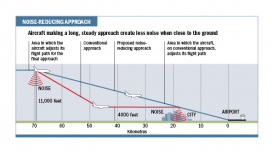Public Launch Slated for New Aviation Environmental Tool
The Federal Aviation Administration (FAA) and Volpe are poised to launch a new environmental analysis tool that will offer a robust, integrated way to quantify the environmental impact of aviation—from a single flight up to full-scale global impacts.
The FAA's Office of Environment and Energy will begin in early 2012 its phased public rollout of the Aviation Environmental Design Tool (AEDT), a software system that dynamically models flight, taking into account the aircraft weight, performance characteristics, and weather conditions, and calculates the resulting noise, air quality, greenhouse gas emissions, and fuel burn. This capability will allow users to analyze the trade-offs between noise, fuel burn, and emissions, and quantify the environmental impact of changes in a flight's trajectory or an engine's design.
"The reality is, there are environmental tradeoffs in aviation, and AEDT will, for the first time, provide the analyst with a means of understanding these tradeoffs in a robust, meaningful way," said Gregg Fleming, director of Volpe's Center for Environmental and Energy Systems. Volpe is the lead AEDT developer, functioning as the system architect and integrator of all modules and related databases. "As the FAA moves towards NextGen, it is critical to be able to accurately quantify fuel burn changes associated with various NextGen initiatives, and AEDT provides that capability," Fleming said.
Part of a broader suite of FAA analysis tools, AEDT is used by the U.S. Government and supports domestic decisions related to NextGen, as well as international policymaking within the International Civil Aviation Organization.
In its ability to capture the gate-to-gate, integrated environmental impacts of flight, AEDT offers substantial enhancements over existing air quality and noise analysis tools, which model only individual environmental consequences (like noise or emissions) for a single airport or region. As another major advancement over legacy systems, AEDT incorporates geographic information systems, which provide the environmental analysis with a data-driven visual representation of aviation operations in concert with noise, air quality, greenhouse gas emissions, and fuel burn.
In the development of this multi-year, multi-million-dollar project, Volpe's software architects, aviation engineers and specialists, acousticians, and emissions and dispersion modeling experts have worked collaboratively with a team of over 70 people that includes the FAA, the National Aeronautics and Space Administration (NASA), MIT, Georgia Tech, ATAC Corp., CSSI Inc., Metron Aviation, and Wyle Laboratories.
The first public version of AEDT that is slated for release in early 2012 will provide regional noise modeling capabilities. Once the full public software version is rolled out, AEDT will be used by government, industry, and academia—both nationally and internationally—with an estimated user base of 3,000-plus.

In conventional landings, airline pilots descend and level off in stages as they approach an airport. However, in continuous descent arrivals, pilots throttle back to idle power at the point of initial descent and glide into an airport, burning less fuel and creating less noise and emissions in the process. AEDT provides the capability for the first time to be able to analyze the benefits of continuous descent arrivals.
